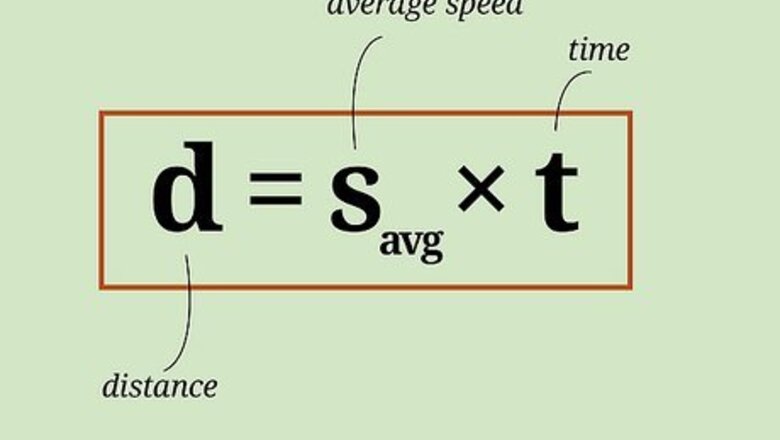
views
X
Research source
Distance can refer to the space between two stationary points (for instance, a person's height is the distance from the bottom of his or her feet to the top of his or her head) or can refer to the space between the current position of a moving object and its starting location. Most distance problems can be solved with the equations d = savg × t where d is distance, savg is average speed, and t is time, or using d = √((x2 - x1)2 + (y2 - y1)2), where (x1, y1) and (x2, y2) are the x and y coordinates of two points.
Finding Distance with Average Speed and Time
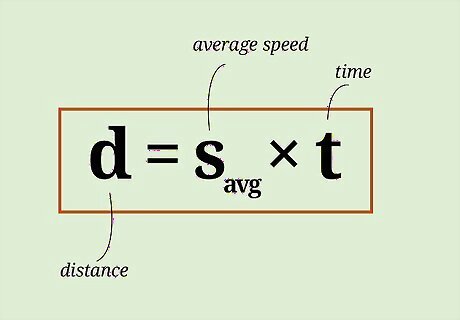
Find values for average speed and time. When you try to find the distance a moving object has traveled, two pieces of information are vital for making this calculation: its speed (or velocity magnitude) and the time that it has been moving. With this information, it's possible to find the distance the object has traveled using the formula d = savg × t. To better understand the process of using the distance formula, let's solve an example problem in this section. Let's say that we're barreling down the road at 120 miles per hour (about 193 km per hour) and we want to know how far we will travel in half an hour. Using 120 mph as our value for average speed and 0.5 hours as our value for time, we'll solve this problem in the next step.

Multiply average speed by time. Once you know the average speed of a moving object and the time it's been traveling, finding the distance it has traveled is relatively straightforward. Simply multiply these two quantities to find your answer. Note, however, that if the units of time used in your average speed value are different than those used in your time value, you'll need to convert one or the other so that they are compatible. For instance, if we have an average speed value that's measured in km per hour and a time value that's measured in minutes, you would need to divide the time value by 60 to convert it to hours. Let's solve our example problem. 120 miles/hour × 0.5 hours = 60 miles. Note that the units in the time value (hours) cancel with the units in the denominator of the average speed (hours) to leave only distance units (miles).
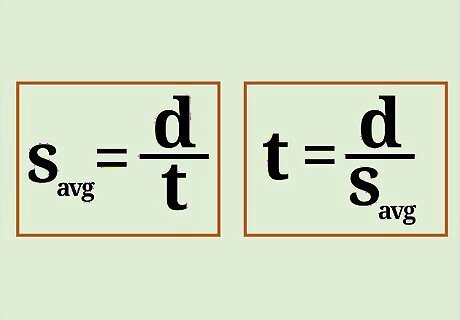
Manipulate the equation to solve for other variables. The simplicity of the basic distance equation (d = savg × t) makes it quite easy to use the equation for finding the values of variables besides distance. Simply isolate the variable you want to solve for according to the basic rules of algebra, then insert values for your other two variables to find the value for the third. In other words, to find your object's average speed, use the equation savg = d/t and to find to find the time an object has been traveling, use the equation t = d/savg. For instance, let's say that we know that a car has driven 60 miles in 50 minutes, but we don't have a value for the average speed while traveling. In this case, we might isolate the savg variable in the basic distance equation to get savg = d/t, then simply divide 60 miles / 50 minutes to get an answer of 1.2 miles/minute. Note that in our example, our answer for speed has an uncommon units (miles/minute). To get your answer in the more common form of miles/hour, multiply it by 60 minutes/hour to get 72 miles/hour. EXPERT TIP Joseph Meyer Joseph Meyer Math Teacher Joseph Meyer is a High School Math Teacher based in Pittsburgh, Pennsylvania. He is an educator at City Charter High School, where he has been teaching for over 7 years. Joseph is also the founder of Sandbox Math, an online learning community dedicated to helping students succeed in Algebra. His site is set apart by its focus on fostering genuine comprehension through step-by-step understanding (instead of just getting the correct final answer), enabling learners to identify and overcome misunderstandings and confidently take on any test they face. He received his MA in Physics from Case Western Reserve University and his BA in Physics from Baldwin Wallace University. Joseph Meyer Joseph Meyer Math Teacher To solve an equation for a variable like "x," you need to manipulate the equation to isolate x. Use techniques like the distributive property, combining like terms, factoring, adding or subtracting the same number, and multiplying or dividing by the same non-zero number to isolate "x" and find the answer.
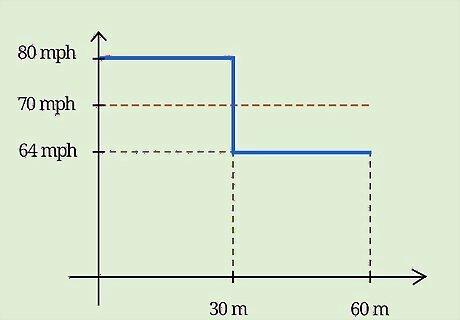
Note that the "savg" variable in the distance formula refers to average speed. It's important to understand that the basic distance formula offers a simplified view of the movement of an object. The distance formula assumes that the moving object has constant speed — in other words, it assumes that the object in motion is moving at a single, unchanging rate of speed. For abstract math problems, such as the ones you may encounter in an academic setting, sometimes it's still possible to model an object's motion using this assumption. In real life, however, this model often doesn't accurately reflect the motion of moving objects, which can, in reality, speed up, slow down, stop, and reverse over time. For instance, in the example problem above, we concluded that to travel 60 miles in 50 minutes, we'd need to travel at 72 miles/hour. However, this is only true if travel at one speed for the entire trip. For instance, by traveling at 80 miles/hr for half of the trip and 64 miles/hour for the other half, we will still travel 60 miles in 50 minutes — 72 miles/hour = 60 miles/50 min = ????? Calculus-based solutions using derivatives are often a better choice than the distance formula for defining an object's speed in real-world situations because changes in speed are likely.
Finding the Distance between Two Points
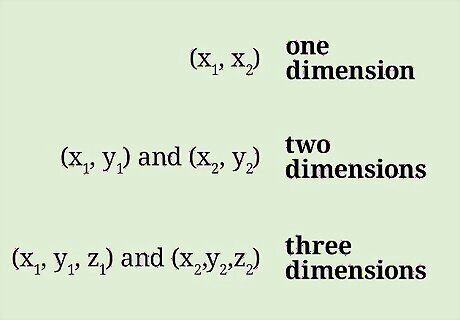
Find two points spatial coordinates. What if, rather than finding the distance that a moving object has traveled, you need to find the distance between two stationary objects? In cases like this, the speed-based distance formula described above won't be of any use. Luckily, a separate distance formula can be used to easily find the straight-line distance between two points. However, to use this formula, you'll need to know the coordinates of your two points. If you're dealing with one-dimensional distance (such as on a number line), your coordinates will be two numbers, x1 and x2. If you're dealing with distance in two dimensions, you'll need values for two (x,y) points, (x1,y1) and (x2,y2). Finally, for three dimensions, you'll need values for (x1,y1,z1) and (x2,y2,z2).
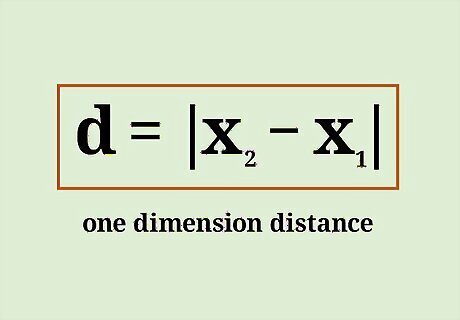
Find 1-D distance by subtracting the value of the coordinates for the two points. Calculating one-dimensional distance between two points when you know the value for each is a cinch. Simply use the formula d = |x2 - x1|. In this formula, you subtract x1 from x2, then take the absolute value of your answer to find the distance between x1 and x2. Typically, you'll want to use the one-dimensional distance formula when your two points lie on a number line or axis. Note that this formula uses absolute values (the "| |" symbols). Absolute values simply mean that the terms contained within the symbols become positive if they are negative. For example, let's say that we're stopped by the side of the road on a perfectly straight stretch of highway. If there is a small town 5 miles ahead of us and a town 1 mile behind us, how far apart are the two towns? If we set town 1 as x1 = 5 and town 2 as x1 = -1, we can find d, the distance between the two towns, as follows: d = |x2 - x1| = |-1 - 5| = |-6| = 6 miles.

Find 2-D distance by using the Pythagorean theorem. Finding distance between two points in two-dimensional space is more complicated than in one dimension, but is not difficult. Simply use the formula d = √((x2 - x1) + (y2 - y1)). In this formula, you subtract the two x coordinates, square the result, subtract the y coordinates, square the result, then add the two intermediate results together and take the square root to find the distance between your two points. This formula works in the two-dimensional plane — for example, on basic x/y graphs. The 2-D distance formula takes advantage of the Pythagorean theorem, which dictates that the hypotenuse of a right triangle is equal to the square root of the squares of the other two sides. For example, let's say that we have two points in the x-y plane: (3, -10) and (11, 7) that represent the center of a circle and a point on the circle, respectively. To find the straight-line distance between these two points, we can solve as follows: d = √((x2 - x1) + (y2 - y1)) d = √((11 - 3) + (7 - -10)) d = √(64 + 289) d = √(353) = 18.79
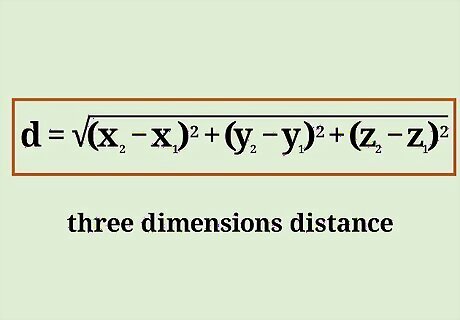
Find 3-D distance by modifying the 2-D formula. In three dimensions, points have a z coordinate in addition to their x and y coordinates. To find the distance between two points in three-dimensional space, use d = √((x2 - x1) + (y2 - y1) + (z2 - z1)). This is a modified form of the two-dimensional distance formula described above that takes the z coordinates into account. Subtracting the two z coordinates, squaring them, and proceeding through the rest of the formula as above will ensure your final answer represents the three-dimensional distance between your two points. For example, let's say that we're an astronaut floating in space near two asteroids. One is about 8 kilometers in front of us, 2 km to the right of us, and 5 miles below us, while the other is 3 km behind us, 3 km to the left of us, and 4 km above us. If we represent the positions of these asteroids with the coordinates (8,2,-5) and (-3,-3,4), we can find the distance between the two as follows: d = √((-3 - 8) + (-3 - 2) + (4 - -5)) d = √((-11) + (-5) + (9)) d = √(121 + 25 + 81) d = √(227) = 15.07 km




















Comments
0 comment